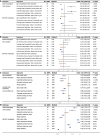Socioeconomic traits and the risk of Barrett's esophagus and gastroesophageal reflux disease: A Mendelian randomization study
- PMID: 38994145
- PMCID: PMC11236248
- DOI: 10.4251/wjgo.v16.i6.2631
Socioeconomic traits and the risk of Barrett's esophagus and gastroesophageal reflux disease: A Mendelian randomization study
Abstract
Background: Previous observational studies have shown that the prevalence of gastroesophageal reflux disease (GERD) and Barrett's esophagus (BE) is associated with socioeconomic status. However, due to the methodological limitations of traditional observational studies, it is challenging to definitively establish causality.
Aim: To explore the causal relationship between the prevalence of these conditions and socioeconomic status using Mendelian randomization (MR).
Methods: We initially screened single nucleotide polymorphisms (SNPs) to serve as proxies for eight socioeconomic status phenotypes for univariate MR analysis. The inverse variance weighted (IVW) method was used as the primary analytical method to estimate the causal relationship between the eight socioeconomic status phenotypes and the risk of GERD and BE. We then collected combinations of SNPs as composite proxies for the eight socioeconomic phenotypes to perform multivariate MR (MVMR) analyses based on the IVW MVMR model. Furthermore, a two-step MR mediation analysis was used to examine the potential mediation of the associations by body mass index, major depressive disorder (MDD), smoking, alcohol consumption, and sleep duration.
Results: The study identified three socioeconomic statuses that had a significant impact on GERD. These included household income [odds ratio (OR): 0.46; 95% confidence interval (95%CI): 0.31-0.70], education attainment (OR: 0.23; 95%CI: 0.18-0.29), and the Townsend Deprivation Index at recruitment (OR: 1.57; 95%CI: 1.04-2.37). These factors were found to independently and predominantly influence the genetic causal effect of GERD. Furthermore, the mediating effect of educational attainment on GERD was found to be mediated by MDD (proportion mediated: 10.83%). Similarly, the effect of educational attainment on BE was mediated by MDD (proportion mediated: 10.58%) and the number of cigarettes smoked per day (proportion mediated: 3.50%). Additionally, the mediating effect of household income on GERD was observed to be mediated by sleep duration (proportion mediated: 9.75%).
Conclusion: This MR study shed light on the link between socioeconomic status and GERD or BE, providing insights for the prevention of esophageal cancer and precancerous lesions.
Keywords: Barrett’s esophagus; Gastroesophageal reflux disease; Multivariate Mendelian randomization; Socioeconomic status; Two-step Mendelian randomization.
©The Author(s) 2024. Published by Baishideng Publishing Group Inc. All rights reserved.
Conflict of interest statement
Conflict-of-interest statement: The authors declare that they have no conflicts of interest.
Figures



Similar articles
-
Association of educational attainment with esophageal cancer, Barrett's esophagus, and gastroesophageal reflux disease, and the mediating role of modifiable risk factors: A Mendelian randomization study.Front Public Health. 2023 Mar 28;11:1022367. doi: 10.3389/fpubh.2023.1022367. eCollection 2023. Front Public Health. 2023. PMID: 37056646 Free PMC article.
-
Causal relationship between cheese intake and risk of gastroesophageal reflux disease and Barrett's esophagus: findings from multivariable mendelian randomization and mediation analysis.Eur J Nutr. 2024 Dec 21;64(1):49. doi: 10.1007/s00394-024-03562-0. Eur J Nutr. 2024. PMID: 39708117
-
Gastroesophageal Reflux Disease and Preterm Birth: Univariate and Multivariate Mendelian Randomization.Int J Womens Health. 2024 Aug 13;16:1389-1399. doi: 10.2147/IJWH.S467056. eCollection 2024. Int J Womens Health. 2024. PMID: 39157004 Free PMC article.
-
Evaluation for causal effects of socioeconomic traits on risk of female genital prolapse (FGP): a multivariable Mendelian randomization analysis.BMC Med Genomics. 2023 Jun 9;16(1):125. doi: 10.1186/s12920-023-01560-5. BMC Med Genomics. 2023. PMID: 37296408 Free PMC article.
-
The Association Between Gastroesophageal Reflux Disease and Atrial Fibrillation: A Systematic Review and Meta-Analysis.Cureus. 2025 Feb 1;17(2):e78356. doi: 10.7759/cureus.78356. eCollection 2025 Feb. Cureus. 2025. PMID: 40034621 Free PMC article. Review.
Cited by
-
A bidirectional Mendelian randomization study integrating genome-wide association studies, expression quantitative trait locus, and methylation quantitative trait locus data revealed causal relationship between heavy cigarette dependence and Barrett's esophagus.SAGE Open Med. 2025 Feb 7;13:20503121251316595. doi: 10.1177/20503121251316595. eCollection 2025. SAGE Open Med. 2025. PMID: 39925959 Free PMC article.
-
Is skimmed milk really heart-healthy?: A mediation Mendelian randomization analysis of coronary risk via serum metabolites.Medicine (Baltimore). 2025 Aug 22;104(34):e42653. doi: 10.1097/MD.0000000000042653. Medicine (Baltimore). 2025. PMID: 40859556 Free PMC article.
References
-
- Maret-Ouda J, Markar SR, Lagergren J. Gastroesophageal Reflux Disease: A Review. JAMA. 2020;324:2536–2547. - PubMed
-
- Mittal R, Vaezi MF. Esophageal Motility Disorders and Gastroesophageal Reflux Disease. N Engl J Med. 2020;383:1961–1972. - PubMed
-
- He J, Ma X, Zhao Y, Wang R, Yan X, Yan H, Yin P, Kang X, Fang J, Hao Y, Li Q, Dent J, Sung JJ, Zou D, Wallander MA, Johansson S, Liu W, Li Z. A population-based survey of the epidemiology of symptom-defined gastroesophageal reflux disease: the Systematic Investigation of Gastrointestinal Diseases in China. BMC Gastroenterol. 2010;10:94. - PMC - PubMed
LinkOut - more resources
Full Text Sources

